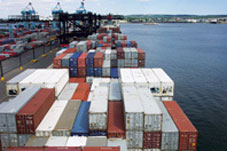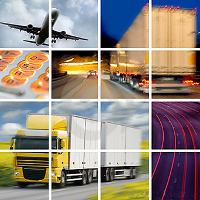 LOSS PREVENTION IN CONTAINERIZED CARGO
LOSS PREVENTION IN CONTAINERIZED CARGO
The use of intermodal containers for the transport of a great variety of cargo has become increasingly popular in recent years. Intermodalism – a concept that embraces the movement and transfer of standardized cargo containers by sea, air and surface has greatly reduced cargo handling, particularly in Door-to-Door shipments.
Development of specialized containers with a wide range of types, sizes and configurations permits containerization of most cargo.
Prompt, undamaged arrival of the complete shipment at destination is the primary objective of the shipper. In committing goods to containerized transport, the shipper can reduce losses by:
• Select the proper container service.
• Selecting the right type of container for the goods in question.
• Inspecting the container to ensure proper accommodation and protection of goods.
• Packaging goods to withstand the hazards of the “toughest leg of the journey.”
• Stowing and securing goods in the container to prevent damage to the goods, container and transport vehicle.
• Properly describing and documenting the container contents, locking and sealing the container and recording container and seal numbers on all shipping documents.
• Timely unloading at destination.
INTERMODAL VARIATIONS
The popular intermodal container, adapt-able to carriage by truck chassis, railcar, barge and oceangoing vessel, is the most common form of containerization. The considerations governing preparation and stowage of the cargo in these containers are no less applicable to other methods of cargo transport.
Trailer-on-Flatcar (TOFC)
“Piggy-backing” highway trailers on container chassis that can be carried on specially equipped rail flatcars.
Container-on-a-Flatcar (COFC)
A carriage of intermodal containers detached from their highway chassis and “boggie” on rail flatcars.
Two recent developments in the rail movement of containers/trailers on flat cars have been introduced into the domestic (U.S.) market.
Double Stack Train
This service involves a series of containers/trailers, stacked 2 high on specially designed rail cars. Linking the major trading corridors, this system is designed to provide smoother rides than their surface competition, either truck, conventional flatcar or alternative rail equipment. In addition, a number of technical features enable high-speed transit with a minimum of shock and vibration to cargo through the dampening of slack, sway and vertical acceleration forces. To date, this method of transportation has demonstrated substantial reduction of damage and increased efficiency.
Trailer-Rail
This new piggyback sys-tem will allow railroads to handle the full range of increasing diversity of trailer lengths over shorter hauls. The full system is composed of the following 3 components.
• The Trailer-Rail terminal, a bare-bones rail yard consisting of a track, parking area, driveway and ramp for handling the trailer on and off the railcars.
• The Tractor-Railer, a lightweight highway tractor, equipped with retractable steel railroad wheels that can both load and un-load trailers in the rail yard and pull a Trailer-Railer and train on the rails.
• The Trailer-Railer, the central part of the system, a short, four-wheeled car of skeletal design, with a drop deck platform that connects the front end of one trailer and the rear of another.
The entire loading cycle involves a tractor trailer driver backing a trailer into the drop deck of the railcar, “jackknifing” the trailer parallel with the track and positioning the trailer landing gear adjacent to a loading stanchion located at the side of the track. This stanchion is manually rotated across the track beneath the trailer landing pads. The driver then activates the hydraulic lift wheel of the tractor to lower the trailer until the landing gear rests on the stanchion. The next rail car is now able to be rolled into place.
Containerization and double stacking have led to increased use of land-bridging, i.e. ocean shipments from the Far East to West Coast ports and then trans-porting the cargo to inland markets via rail or truck. In Europe this concept is termed Microbridge or IPI (Interior Point Intermodal).
SEA-AIR
The growing practice of routing cargo by both sea and air within a single journey has been somewhat obscured by the Double-Stack and other land-bridge developments. No longer stymied by incompatible equipment and scheduling, the ocean to air transshipment is now able to marry the low cost of ocean shipping with the timely convenience of air freight. Examples of this trade pattern include a sea-air leg originating in Japan and moving to North America’s West Coast via ship. From there cargo is transferred to air freighter or combination passenger-cargo plane for the flight to Europe.
Other routes involving traffic to/ through South America and the Middle East have also been active. One of the problems inherent in this transportation hybrid is the increased exposure to loss and damage during cargo transfer between the two modes. Some shippers have resorted to shipping loaded air cargo containers inside 20- and 40-foot long intermodal units for the sea transit.
Air Cargo Containerization
The unique aspects of cargo carriage via air and the application of Containerization to this transport mode are treated separately in this booklet. (See Air Cargo discussion.)
CONTAINER SERVICES
Door-to-Door (House-to-House)
The greatest benefits of Containerization are realized when the shipper uses the container to carry goods directly from his or her premises to his or her customer’s location. Perhaps the only time the container will be opened while enroute is for Customers inspection. Reduced susceptibility to pilferage and theft, elimination of multiple handling of individual items of cargo and the least possible exposure to the elements are all attractive features of Door-to-Door service.
In utilizing this type of service, the shipper accepts the additional responsibility’ of ensuring that cargo is properly stowed and secured in the container, precluding damage to the cargo, container or transport vehicle.
The tendency to reduce packing protection of cargo destined for Door-to-Door container shipment must be resisted. The ocean leg of the voyage will still subject the cargo to severe motion stresses, considerably greater in force than during highway or rail movement.
Reduction of packing protection must be carefully evaluated and implemented only after due consideration of the hazards of ocean transport, including the lifting force at transshipment points.
Port-to-Port (Pier-to-Pier)
When cargo volume does not provide for a full container load (less than container load or LCL) or when the shipper or consignee does not have the facilities to load or un-load the containerized cargo at his premises, he or she can utilize the services of forwarders, consolidators or the carrier to stow the goods in containers at the port of departure.
This service is less attractive than Door-to-Door service. Since the cargo is not in a container for the entire journey, it is subject to the same degree of exposure to weather, handling and stow-age damage and theft/pilferage as break-bulk cargo.
MAXIMUM EXPORT PACKING STANDARDS
ARE REQUIRED WHEN SHIPPING PORT-TO-PORT,
Door-to-Port
Combinations of Door-to-Door and Port-to-Port service are possible, depending on the desires of the ship-per and the facilities available. While these combinations are more advantageous than Port-to-Port service, the cargo will still be exposed to the hazards of theft, weather and additional handling during part of the journey.
AS IN PORT-TO-PORT SERVICE, THE CARGO MUST BE PACKED TO THE HIGHEST EXPORT STANDARDS.
LCL (Less than Container Load)
On LCL shipments, the shipper can still load goods into a container, but the container will be delivered to a consolidation point at the pier where other
shippers’ goods will also be stowed in the container. What this means is that the smaller, low-volume exporter can still have cargo containerized, although this is not as desirable as a sealed
House-to-House container.
SELECTING THE RIGHT CONTAINER
Consultation with the carrier will permit selection of the type and size container most suitable for the cargo.
Many types and sizes are available to the shipper. The most common is the dry cargo container that may be used for a great variety of general cargo. Specialized containers should be used for goods or commodities requiring special environments.
Particular attention must be given to the container weight limitations so as not to overload.
Cargo Containers
End Loading, Fully Enclosed
The basic intermodal container with end doors, suitable for general cargo not requiring environmental control while enroute.
Side Loading, Fully Enclosed
Equipped with side doors for use in stowing and discharge of
cargo where it is not practical to use end doors, as when the container must remain on a railcar while cargo is placed in or removed from the container.
Open Top
Used for carriage of heavy, bulky or awkward items were loading or discharge of the cargo through end or side doors is not practical. Most open top containers are equipped with fabric covers and are often termed “soft” or “rag” top containers.
Some open top versions are fitted with removable hatch-type panel covers or detachable full metal roof.
Ventilated
Equipped with ventilating ports on ends or sides, and used for heat generating cargo or cargo requiring protection from condensation (sweat) damage. Versions with powered air-circulating fans are available. Vents are normally fitted with baffles to prevent entry of sea or rain water.
Insulated
For cargo that should not be exposed to rapid or sudden temperature changes.
Available in ventilated or non-ventilated versions.
Some carriers provide containers with heating systems for special applications
Refrigerated
Insulated and equipped with a built-in refrigeration sys-tem, powered by direct electrical connection or by diesel or gasoline generator. It is used primarily for foods or other commodities requiring a temperature con-trolled environment.
Liquid Bulk
Tank-type containers for carriage of liquids. Some have been designed to high level specifications for carriage of certain hazardous materials.
Dry Bulk
Designed for carriage of bulk cargo such as dry chemicals and grains.
Flat Rack
Available in a variety of sizes and models, the flat racks are used for lumber, mill products, large, heavy, bulky items, machinery and vehicles. Some are equipped with removable sides.
Auto
Used for carriage of vehicles and available in enclosed or open versions.
Livestock
Configured for the nature of livestock carried; containers are available for transporting poultry, cattle and other livestock.
Also, transport boxes can be loaded onto flats.
Controlled Atmosphere
These systems carry a cylinder of liquid nitrogen and carbon dioxide. Through computer-based controls, the atmosphere within the container can be maintained at pre-set levels to meet requirements of commodity carried. Used mainly in the transport of produce to extend the post-harvest and storage life.
High Cube
These containers are used for high volume/low weight cargo and can greatly increase the cubic area available for cargo stowage. High cube containers are in heights to 9.5 feet and to lengths of a maximum of 48 feet.
Garment
With special tie downs and internal ceiling fittings, this container can handle hanging garments.
CERTIFICATION OF INTERMODAL CONTAINERS
The International Convention for Safe Containers (ICSC), effective 6/9/1977, made certain structural requirements mandatory for containers moving in international trade. Under the Convention, approved units are issued safety plates that are ffixed to the container at the time of manufacture.
In addition, ACEP (Approved Continuous Examination Programs) or periodic examinations of containers in accordance with procedures prescribed or approved by signatory governments are required.
The owner or operator must maintain the container in safe condition.
A number of independent firms pro-vide testing and inspection services for intermodal container operators. Certification of adequacy of construction occurs prior to delivery of the new container to the carrier and periodic inspections must be performed beginning five (5) years after manufacture. Maximum periodic examination interval is 30 months.
The shipper should look for the safety plate and ACEP or examination decal to determine that the container(s) supplied for his use have met adequate construction and maintenance standards.
Presence of the safety plate and examination decal is not, however, a guarantee that the container is presently free from defects, as damage may have occurred since the last certification inspection.
The shipper must take a personal inspection of the container before use to be absolutely certain that it is in condition to adequately protect his goods.
An understanding of the hazards to which a container may be exposed (as depicted in the two illustrations on pg 69) is essential. This knowledge will permit intelligent inspection of the container and also provide the background necessary for adequate preparation and stowage of the cargo.
INSPECTING THE INTERMODAL CONTAINER
With the advent of Containerization, it was anticipated that cargo damages would be greatly reduced. This has been realized; however, it is largely dependent upon the structural integrity of the container.
The following checklist will assist you in inspecting me container to be sure it will properly protect your cargo. Containers that leak or have inherent defects that endanger the cargo or pose a safety hazard to personnel must be rejected.
The interior must be free from splinters, snags, dents or bulges. These may interfere with loading. Serious defects indicate the container is structurally unsound.
Watertight Integrity
“Light” tests whereby you enter the container, have the doors closed and look for light entry via the roof, side and door panels and deck are a must. Also, previous patches and re-pairs must be checked to ensure they are watertight. Hose (water) or smoke tests are alternative methods of discovery.
Fittings
Cargo tie-down cleats or rings should be in good condition and well anchored. If ventilation openings are present, be sure that they have not been blocked off, and that they are equipped with baffles to prevent rain or sea water entry.
Cleanliness
Free of residue from previous cargo particularly odors that may taint your goods.
Also, check the container for nails or protruding fastenings that might puncture cargo package or inflatable dunnage.
The exterior must be free from dents, bulges or other damages; all may interfere with handling.
Doors
Be sure doors can be securely locked and sealed: Check that door gaskets are in good condition and watertight when closed. Inspect door hardware closely If bolts or nuts can be easily removed from the outside with simple tools, it means that the container can be opened without breaking the seal or lock an attractive invitation to the pilferer.
Fittings
A quick look at the lifting fittings at each corner of the container will reveal those that are obviously damaged or unsafe. Check the fittings that secure the container to the trailer chassis; they should all be in working order and in use.
Covers/Hatch Panels
If an open-top container, be sure that the fabric cover supplied with the container is in good condition and can be properly secured. Check hatch panels for close watertight fit.
The following is a partial checklist of typical types of damage.
Front
Front Panel Dented, torn, holed or punctured.
Patches Loose, not of same material as panel, not sealed or riveted with waterproof Customs-
approved rivets, poor welds, not primed or painted.
Top Rail Bent, cut, crushed or fractured.
Comer Post Bent, broken, cut, gashed or distorted.
Upper and Lower Corner Fittings and Attachments Fractured or distorted fitting, cracked attachment welds.
Rivets Loose or missing.
Welds Improperly made, not primed or painted.
Sides
Panels Dented, torn, holed or punctured.
Bent, broken, cut, gashed or distorted.
Upper and Lower Corner Fittings and Attachments Fractured or distorted fittings, cracked attachment welds.
Door Holdbacks Damaged or missing.
Rear
Doors Difficulty in opening and/or closing.
Door Panels (Metal or other)Torn, cut, holed or punctured.
Door Locking Bars (Rods) Seized, bent, broken or twisted.
Door Locking Bar Cams Bent or broken.
Door Handle and Retainers Broken, bent or missing.
Door Cam Lock Retainers (Keepers) Bent or broken.
Door Hinges Broken, torn, twisted, binding or seized.
Door Seals (Gasket and attachments) Cut, torn or loose.
Door Header Cut, broken, distorted or dented.
Door Sill Cut, fractured or distorted.
Anti-Rack Device (if any) Bent, cut, damaged or broken.
Rain Gutter Bent, broken or crushed.
Roof
Panel Punctured, dented or distorted.
Upper Comer Fittings and Attachments Fractured or distorted fittings, cracked attachment welds.
Corner Protection Plate (where provided) Punctured, dented or distorted.
Under Structure
Cross Members and Attachments Crushed, cut, bent, distorted or broken loose from bottom side rails or floor.
Tunnel Recess (if any) Cut, dented, distorted or cracked weld attachments.
Forklift Pockets (if any) Cut, dented, distorted, bottom straps broken or bent.
Interior
Roof Sheet Punctured, dented or distorted.
Roof Bows (if any) Bent, cut or broken loose from roof.
Floor Torn, gouged, broken, shrunken, warped, stained excessively.
Sides Dented, torn, holed or punctured.
Logistic Track (side walls or floor) Torn, loose, bent, missing or cracked welds.
Liners (where provided) Torn, punctured, gouged, pulled loose, stained excessively.
Chassis
Tires Proper inflation, adequate tread depth, damages such as cuts, breaks or separated recap.
Twist Locks Twist lock and lock handles are in good operating order.
Landing Gear Check the pads, crank, crank handle and braces for defective areas.
Lights and Reflectors Check for proper working order.
Frame Look for structural damages.
SPECIALIZED CONTAINER INSPECTION
In addition to the previous container inspection steps, if you are utilizing a refrigerated, tank or other special purpose container, check the following:
Motors/Compressors Check to see that they are in good operating condition and perform as required. Be sure that adequate fuel has been supplied.
Fittings, Valves/Piping They must be free of leaks with tight fittings. Valves should operate smoothly and seal tightly.
Electrical Wiring and connections should be secure, watertight and free of corrosion. Switches should operate properly. Be alert for potential shock hazards.




